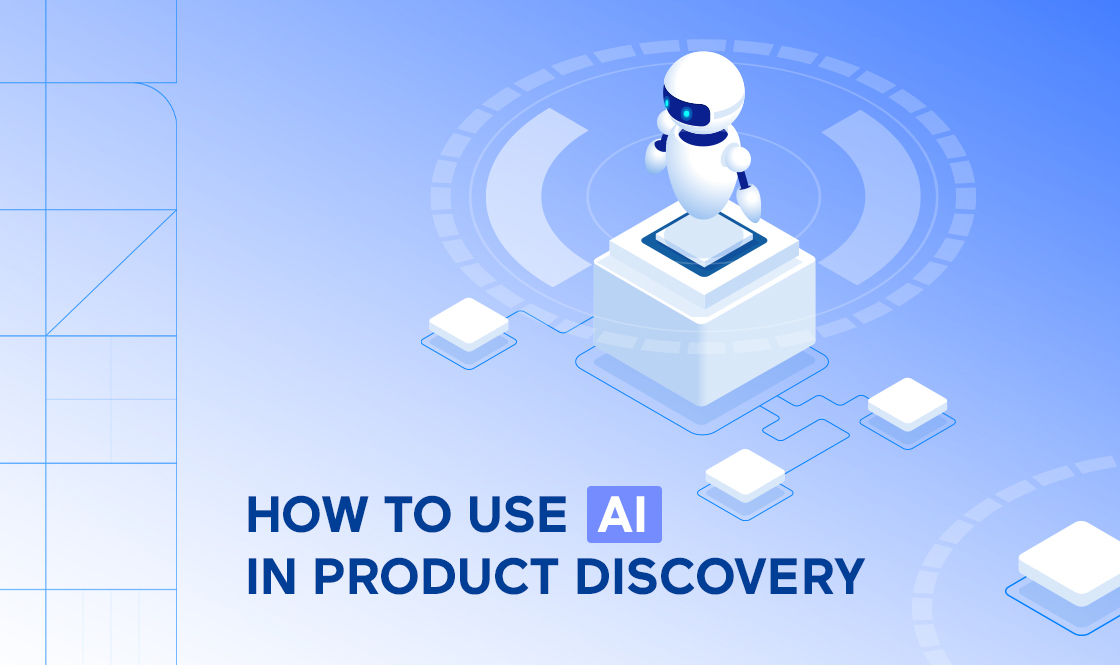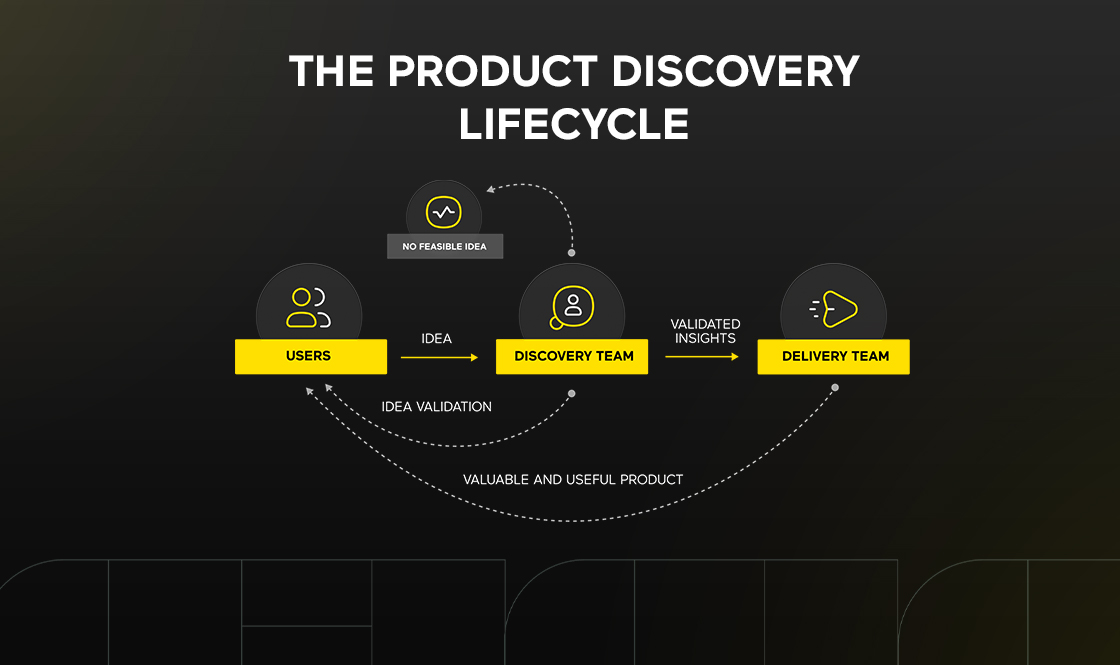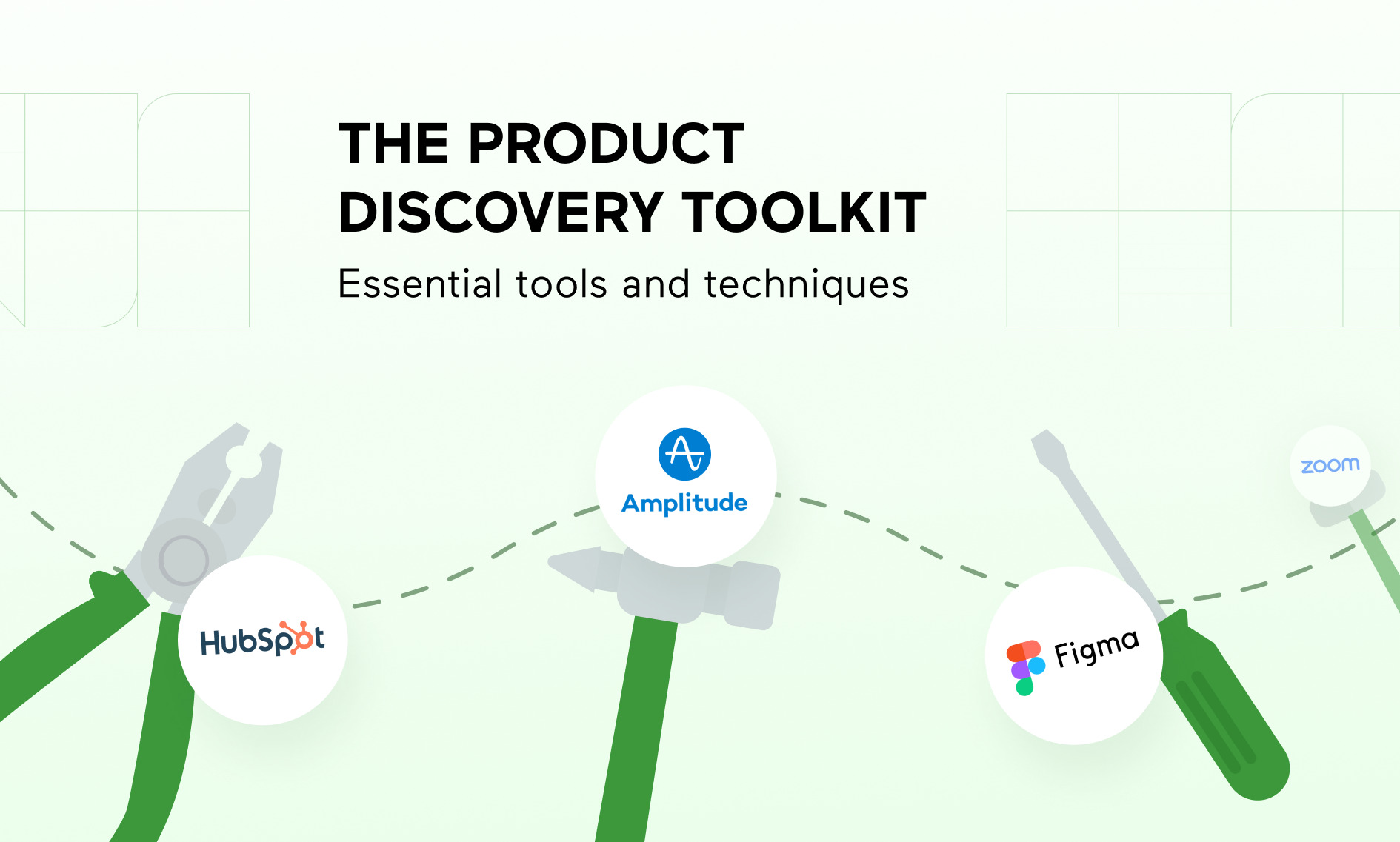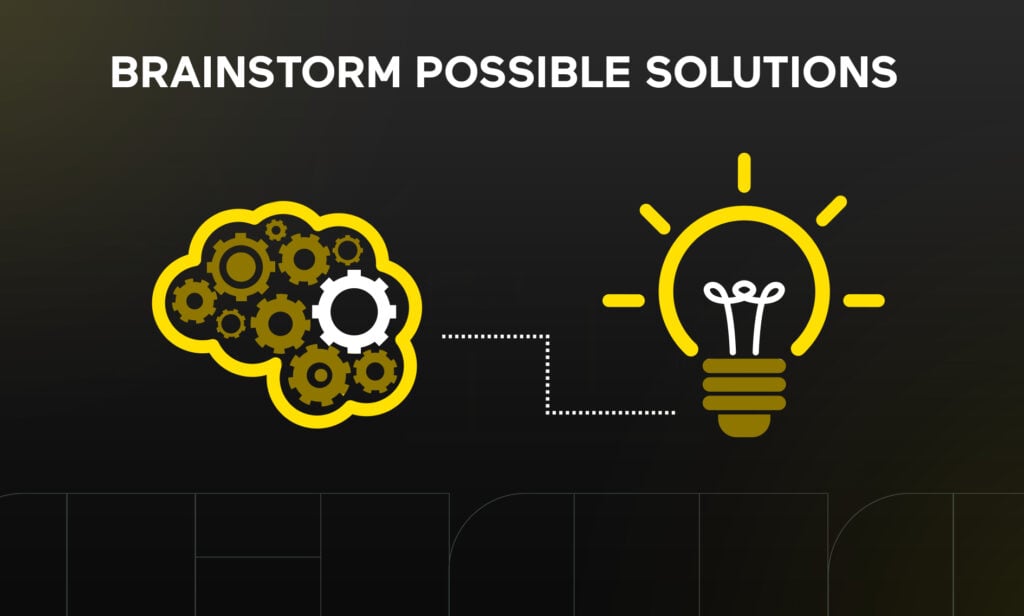
Starting a new business can feel like you’re diving into the great unknown. The statistics speak for themselves: as many as 90% of all startups will fail, with 10% of them crashing and burning within their first year. A key factor behind these grim stats is the inability to accurately gauge market demand and what your core audience needs, which accounts for about 42% of the failures.
As the market changes and customers become more discerning, the process of product discovery before any actual development has never been more crucial. Those who have experienced product failures understand the value of vetting ideas before committing to weeks of development time and allocating additional team resources. It’s essential to determine the problem you’re solving and how it can improve your customers’ lives before investing thousands of dollars on design and development.
Despite being a crucial first step of product development, the discovery phase is often swept under the rug. In this article, we’ll discuss what product discovery is and why it’s a vital step in the development process. Let’s see firsthand how running a product discovery phase before development can improve your product’s success.
What is Product Discovery?
The discovery phase, also known as the research or analysis phase, is all about coming to terms with business needs, user pain points, and requirements. It helps development and product teams curb uncertainty and hone in on solutions to customer issues. Discovery allows teams to determine whether the problem exists for consumers, what kind of product to create, and whether it’s worth creating at all. Through research and discovery, we gain useful insights into what users really need.
Product discovery is a process that focuses on the needs and wants of customers to determine whether or not a product or feature should be developed. Each team or company will have their own approach to product discovery, but the ultimate goal is always the same: to create products that meet the needs of customers and solve their problems.
Anna Yazvinskaya,Chief Business Architect in Business Analysis, Spiral Scout
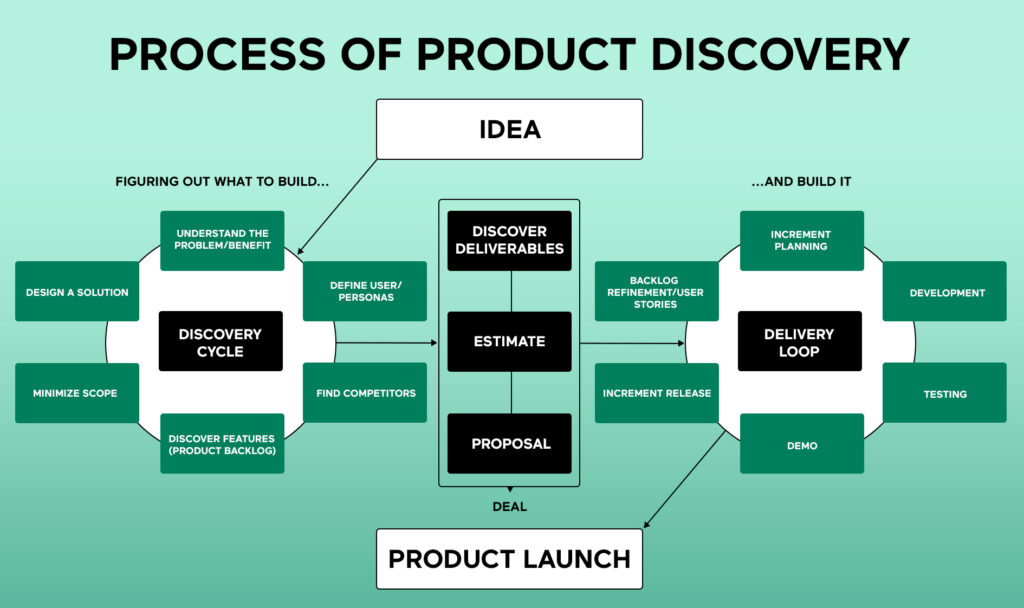
Why Is Product Discovery Important?
During the discovery phase, the main goal is to validate the business idea and determine if it’s worthwhile to invest time and resources into the project. It’s essential to ensure that the product addresses a real problem for actual people.
After all, a lack of market demand is the top reason for startup failure. By conducting thorough research during the product discovery phase, you’ll have the answers you need to make informed decisions about whether to proceed with product development. But that’s not all – without a well-defined product discovery process, precious resources could be squandered on products that don’t effectively meet user needs.
At Spiral Scout, we know that starting development without a clear vision of the product’s scope and goals is a recipe for mismanaged expectations and project overruns. That’s why we always recommend creating a product discovery blueprint that outlines the target audience and primary problems that the new product or service should address and an initial set of requirements that define success for phase 1.
Discovery Types
Problem discovery starts with a preliminary problem or challenge and ends with a validated problem, commonly called an “opportunity” in the product discovery world. The goal of problem discovery is to understand the primary issues to create superior solutions. At Spiral Scout, we achieve this by conducting primary research, such as user interviews and surveys, as well as secondary research on competitors, product reviews, and so on.
Solution discovery starts by identifying the ultimate problem and concludes with validating the proposed solution. The goal of solution discovery is to develop an optimal first version of the solution that can be delivered to the users. To achieve this, teams engage in initial solution iteration activities such as wireframing, storyboarding, prototyping, and user story mapping. You also see at times that designers will design and build clickable prototypes in tools like Figma to share with potential users and investors without doing any development work in order to get immediate feedback. This feedback from users and stakeholders is then used to refine the solution until it meets the needs of the users.
Discovery: New Products and Updating Existing Products
The approach you take to product discovery depends on whether you’re launching a new product or improving an existing one. For new products, your focus should be on understanding potential customers and their problems and identifying the solutions that your product can offer. For existing products, your attention should be on identifying changes that can increase customer satisfaction and overall product market fit if you have not attained it yet. Insights gained from getting your product into the marketplace can provide valuable information for what should be built next.
Continuous Product Discovery
To thrive in this dynamic landscape, top organizations understand that the improvement of their products is fundamental and constant. New technologies and trends are always emerging, so evaluating and refining digital products must be an ongoing process. This is where continuous discovery comes in. This approach, popularized by Teresa Torres, helps teams understand how their product solves specific problems for customers, how it assists customers in accomplishing their jobs to be done (JTBD), and how it can evolve and continue to serve customers. Put simply, continuous product discovery involves collecting product learnings as we communicate with customers throughout the entire development cycle, and on a continuous basis.
Customer-Centric Approach to Discovery
At the heart of product discovery is understanding your users. Listening to feedback and building empathy with your users are key components to becoming more customer-centric. However, true customer-centricity requires asking deeper questions about their needs and experiences. Understanding the context in which customers will use your product, their interactions with similar/competitors’ products, and whether they’ve tried alternatives can provide invaluable insights into their pain points. Additionally, knowing what your users struggle with and dislike doing or what manual work they are repeating over and over can help you make important improvements to your product.
By adopting a customer-centric approach to the product discovery process, your business will actually build a product that helps and delights a user because of the benefits. This ultimately buys you more time with that user and allows you to build stronger relationships with your end-users.
What Are The Steps of Product Discovery?
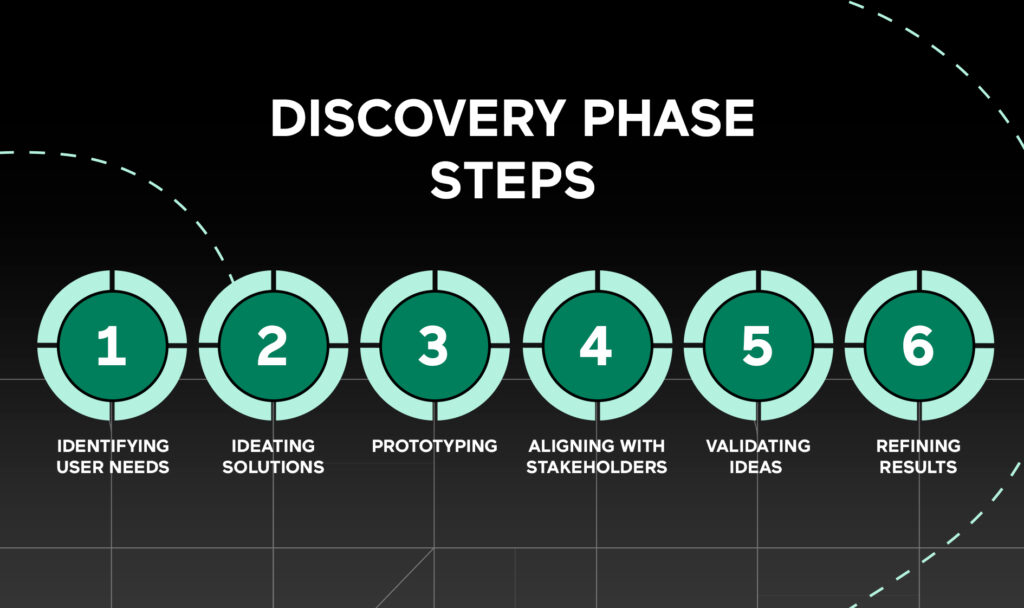
The discovery phase of product development is unique and tailored to the project’s specific requirements. However, there are typical discovery phase steps that are generally followed to ensure success in the discovery phase and can be adjusted based on the specifics of the project:
Step 1: Identifying User Needs. Whether you are building a new solution or enhancing an existing product, start by asking important questions: Who are the users? What challenges does the product solve and what words do they use to describe those challenges? Who are the major competitors and how do they solve the problem? Are the users willing to move to a new product because their needs are not satisfied? Determine the unique value proposition that differentiates your product or service from the competition.
Step 2: Brainstorming Solutions. Once you have gathered user feedback, pulled together additional points data, and identified their core problems, it’s time to brainstorm different solutions and then pick the best solutions and set up a plan to test it with a prototype in the market. The brainstorming phase is where you can experiment with the ideas and be comfortable knowing you will make mistakes and some ideas will be bad but the good ones should be further discussed. The aim is to determine to the best of your knowledge what path will deliver the most initial value to the customer, buy yourself credibility enough in the marketplace to gather feedback from your users, and then use that feedback to introduce additional features or products to the market if you find yourself on the correct path.
Step 3: Aligning with stakeholders. It’s critical to maintain transparency, clarity, and trust from stakeholders regarding the product’s ability to meet their expectations and deliver desired outcomes. Using a user story map to validate ideas and receive feedback from stakeholders can help identify the product’s right direction. A user story map helps teams visualize the user journey and prioritize features and functionality.
By prioritizing user needs, goals, and activities into user stories, the team creates an intuitive, visual backlog that is easy to understand for everyone. This is called a user story map.
Typically, a user story map consists of two main parts: the horizontal axis and the vertical axis. The horizontal axis represents the product’s features and functionality, while the vertical axis represents the user’s journey. Each feature or functionality is broken down into smaller user stories, which are then mapped onto the user journey.
Step 4: Prototyping. After you have a portion of ideas and roughly evaluated them based on time and budget, it’s essential to validate them with prototypes to visualize and test the user experience (UX) before creating the UI.
Prototyping is the process of creating a preliminary version or model of a product, service, or system to test and evaluate its functionality, usability, and user experience. It is a crucial step in the design and development process as it helps identify potential issues and refine the product design before moving to the final stages of production.
In the early stages of product discovery, a clickable prototype can be a valuable asset to the design process as it allows the team to test and refine the product concept before development. A visual representation of the final product idea allows users to interact with the product as if it were real, without the need for actual development. Moreover, a clickable prototype can be used to test different user scenarios, such as user flows and user journeys. This can help the team to understand how users will interact with the product and what steps they will take to accomplish their goals.
Step 5: Validating Ideas. Before implementing, review ideas and hypotheses to ensure you’re on the right track so as not to invest too much time, money, and effort. Building a product roadmap and interacting with stakeholders to get their feedback and validate ideas can help.
Step 6: Refining Results. In this step, it’s important to focus on all the increments that you must deliver as a team. Using the most pressing user problems as a guideline for priority, rather than personal opinions about favorite features, can help refine the results.
Product Discovery Activities
It’s a time to focus on problems, rather than solutions, and utilize qualitative data to validate the need for the product. This process is typically led by experts such as product managers, business analysts, UI/UX designers, or researchers, and involves rapid experimentation.
To achieve the goal of product discovery, the following factors should be considered:
- Research should be done
- Focus on problems, not solutions
- Utilize primarily qualitative data
- Learn fast
- Validate the need
- Conduct rapid experimentation
Common activities in product discovery process include:
- Interviewing users and exploring problems is a fundamental method to understanding user needs and challenges.
- Sending out surveys to identify problem areas worth solving and to gather data at scale.
- Creating low-fidelity prototypes and conducting usability tests can help validate product ideas and identify design issues.
- Designing experiments and running brainstorming sessions with stakeholders can help generate new ideas and test assumptions.
- Researching and analyzing competitors with a SWOT diagram can help identify gaps in the market and potential opportunities.
- Facilitating workshops can help identify internal challenges and align teams on what metrics to use to define product goals and if they were met successfully.
- Sharing research findings and insights is essential to ensuring that everyone involved in the product development process is well-informed and aligned.
These discovery methods are used to gain a better understanding of user needs, pain points, and preferences. By using a variety of methods, product teams can gather diverse perspectives and identify patterns. The rise of AI and AI-based tools can significantly enhance the product discovery process and its output. By leveraging AI in product discovery, teams can gain a competitive edge and develop products that better meet the needs of their users.
Discovery Phase Deliverables
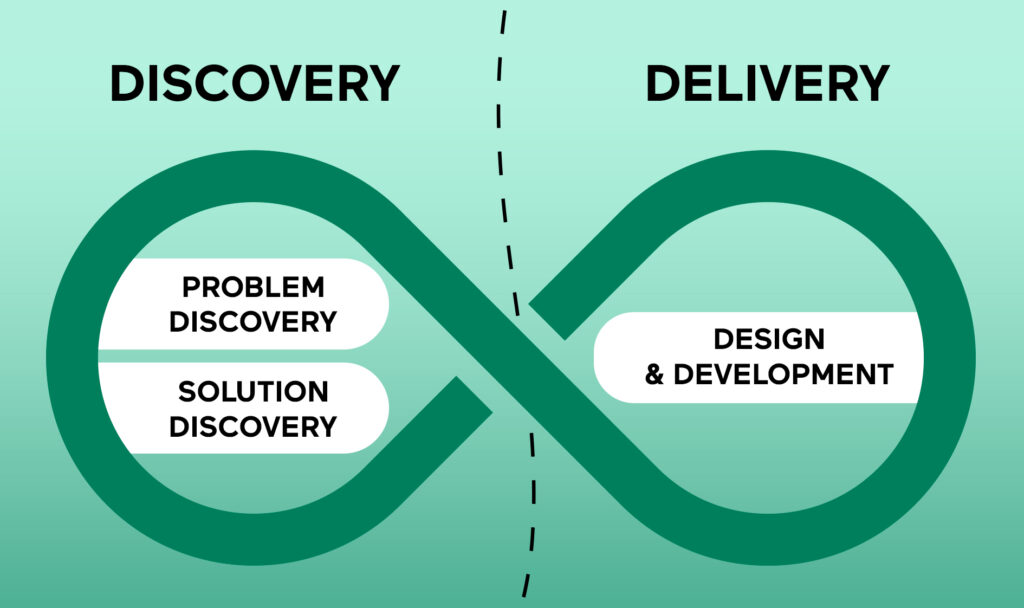
Now let’s move on and take a closer look at some of the key discovery phase deliverables that set the foundation for your product’s success:
- A customer journey map helps the team understand the user’s pain points, goals, and needs at each stage of the journey.
- Feature list helps the team prioritize features based on user needs and business goals.
- Information architecture ensures that the product is intuitive and user-friendly.
- Wireframes and clickable prototypes help the team identify design and usability issues early on in the process.
- A product roadmap provides a clear understanding of what will be delivered, when it will be delivered, and why it is important.
For solution discoveries teams deliver also:
- An estimate is a rough calculation of the resources and time required to complete the project to understand the scope of the project and plan accordingly.
- Tech stack (a list of technologies to build the product) helps the team identify any potential technical challenges and ensure that the product is built using the most appropriate technologies.
Benefits of Product Discovery
The product discovery phase serves as a compass for the product development team, guiding them through the development process, and ensuring that the final product meets the desired standards. The most beneficial things to come out of a product discovery are:
- Empowering Teams: The process of product discovery empowers teams by providing them with a structured approach to evaluate and choose ideas for delivery, that are more likely to succeed in the market, leading to better outcomes.
- Customer-Centric Approach: By understanding user problems, product discovery helps teams focus on developing products that solve real issues and not just another mousetrap. This provides a deep understanding of user needs, desires, what language they use, how they view the current products in the market, and their pain points.
- Defining the Scope: Product discovery defines the project’s scope and desired outcomes. It sets achievable goals within the given time frame and resources, leading in most cases to better planning and execution.
- Understanding Your Market: Product discovery provides valuable insights into customer behavior, preferences, and buying patterns. This helps teams develop a better understanding of their target audience and the competitive landscape.
- Validating Your Ideas: Product discovery validates your ideas against the market state, ensuring that your product meets the needs of your target audience. This approach helps mitigate the risk of developing products that are not marketable.
- Mitigating Risks: By identifying potential risks, product discovery helps teams plan for challenges and develop contingency plans resulting in reducing the risk of unforeseen issues arising during the development process.
- Prioritizing Features: Product discovery helps teams prioritize features critical to the success of their product, laying out the MVP scope, and preventing costly changes during the development phase.
Product Discovery Risks
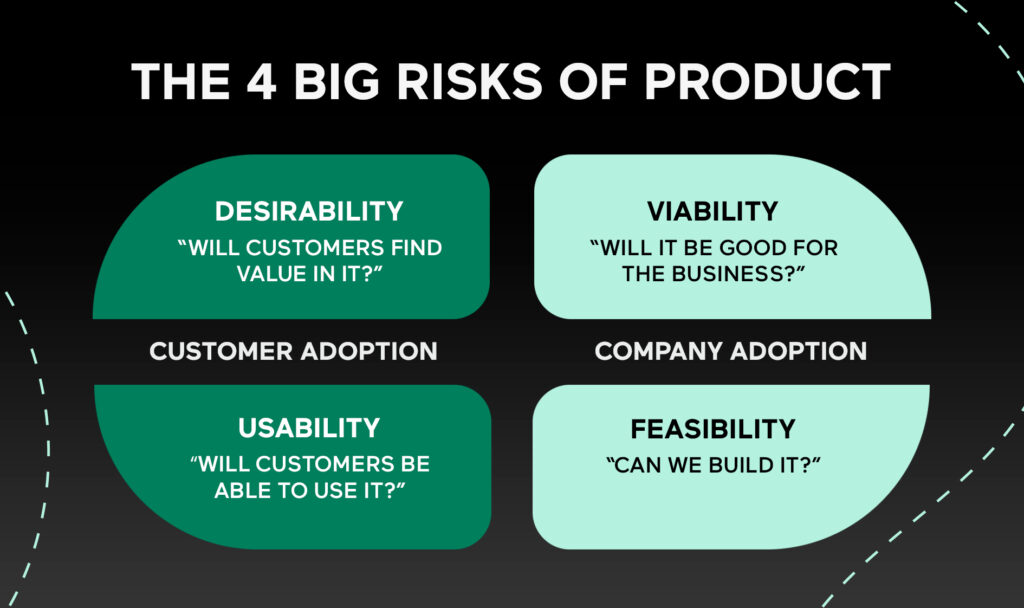
When it comes to product development, consider the potential risks that could arise. As pointed out by Marty Cagan, there are four major risks that product development teams should keep in mind:
- Solving the Wrong Problem could lead to wasted efforts and resources.
- Building the Wrong Thing could result in an ineffective or inefficient solution and wasted time.
- Failing to Achieve User Adoption leads to a product that fails to meet the intended user’s needs.
- Not Delivering the Product on Time or Within Budget could be caused by poor planning, communication, or unforeseen challenges during the development process.
The product discovery process is all about gaining deep insights into the problems and needs of users. By continuously learning and focusing on user needs, product development teams can create solutions that truly address user needs and mitigate the risks of building the wrong thing or failing to achieve user adoption.
Successful Discovery
Successful product development comes from effective product discovery. And remember that this isn’t a one-and-done process. It’s an ongoing activity because the market changes and the customer’s needs are constantly evolving. To ensure your business stays ahead of industry movements keeps customers happy, and maximizes profits, it’s crucial to reevaluate your ideal customers and the products you’re offering them on a regular basis.
It’s important to note that ‘discovery’ isn’t just another term for the analysis, research, and design phases. In fact, until you’ve built part of your solution, put it in the hands of your users, and received feedback, you can’t fully understand it.
To put it all together, the discovery phase is a key aspect of agile product development. It sets the groundwork for the final product, reduces risks, and provides valuable insights that can aid in creating a successful product that meets users’ needs. This phase is akin to being an architect or more specifically laying a firm foundation for a house; without it, the house won’t stand sturdy, and likewise, the product has less chance to succeed.

